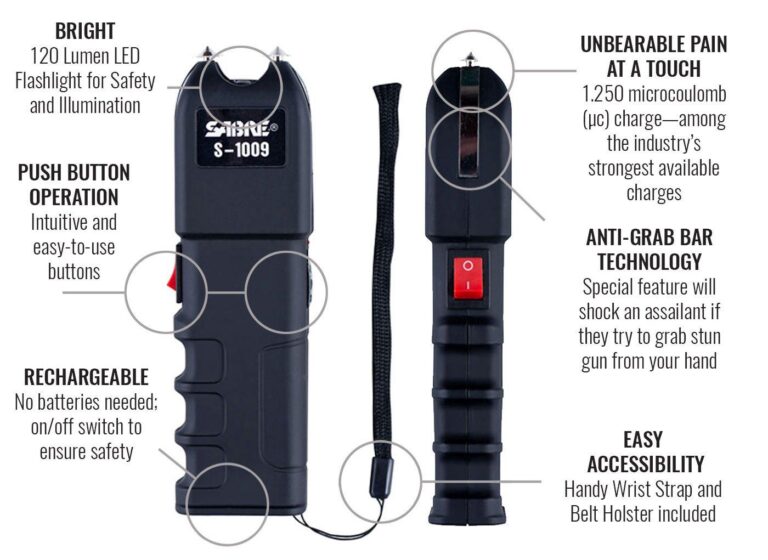Table of Contents
- Choosing the Right Stun Gun for Personal Safety
- Understanding Proper Handling and Grip Techniques
- Key Safety Precautions to Prevent Accidental Discharge
- Effective Strategies for Using a Stun Gun in Emergency Situations
- Wrapping Up
Choosing the Right Stun Gun for Personal Safety
When selecting a stun gun for personal defense, it’s essential to prioritize effectiveness, ease of use, and portability. Look for models that provide a powerful charge capable of incapacitating an attacker quickly but also feature safety mechanisms to prevent accidental discharge. Compact designs are highly recommended as they can be discreetly carried in a pocket or purse, ensuring instant access during emergencies. Additionally, consider stun guns equipped with built-in flashlights or alarms, which can serve as dual-purpose tools in threatening situations.
Key features to keep in mind:
- Voltage strength: Higher voltage usually means stronger incapacitation but balance it with control and legal restrictions.
- Activation method: Simple, intuitive controls reduce fumbling when seconds count.
- Durability: A robust casing can withstand drops or rough handling, ensuring reliability.
- Battery life: Long-lasting batteries or rechargeable options help keep your device ready at all times.
- Legal compliance: Verify local laws to ensure your chosen stun gun is permissible where you live.
Understanding Proper Handling and Grip Techniques
Mastering the way you hold your stun gun is crucial for both your safety and effectiveness during an emergency. When gripping the device, it’s essential to maintain a firm but not overly tight hold to prevent fumbling, especially under stress. Position your thumb on the activation button while keeping your fingers securely wrapped around the grip to ensure immediate access to the stun function. Remember, a relaxed yet controlled grasp allows for smoother deployment and better aim, minimizing the chance of accidental discharge or dropping the device.
Additionally, be mindful of your hand placement and body posture to maximize impact and control. For optimal performance, keep your wrist straight and aligned with your forearm, which helps in absorbing recoil and prevents injury. When ready to deploy, aim for areas where the skin is thinner and nerves are close to the surface. Utilize these tips for proper handling to ensure that your stun gun remains an effective and safe personal defense tool.
- Maintain a secure but relaxed grip to prevent accidental slips.
- Keep your thumb on or near the activation button for rapid response.
- Align your wrist with your forearm to reduce strain on impact.
- Focus on targeting sensitive areas for maximum effectiveness.
Key Safety Precautions to Prevent Accidental Discharge
Handling a stun gun with care is paramount to ensure it functions correctly when needed and to avoid unintended consequences. Always keep the device switched off until you are ready to use it. Avoid gripping the stun gun too tightly or pressing the activation button while holding it in your pocket or bag. Many models come with a safety switch or key; make sure this feature is engaged during storage and transport to prevent accidental activation.
Regularly inspect your stun gun for any signs of wear or damage to the casing and trigger mechanism. When carrying it, use a holster designed specifically for your device to minimize movement and accidental button presses. Additionally, never test a stun gun in an environment with sensitive electronics or flammable materials, and always keep your fingers away from the front electrodes to prevent self-injury. Following these precautions helps ensure your stun gun is reliable and ready to protect you when seconds count.
Effective Strategies for Using a Stun Gun in Emergency Situations
When facing a threatening situation, staying calm and focused is crucial. Before deploying a stun gun, ensure you have a firm grip and maintain a safe distance that allows you to activate the device effectively without compromising your position. Targeting areas with higher nerve density, such as the torso or upper thigh, will maximize the device’s incapacitating effect. Remember, your goal is to create an opportunity to escape, not to engage in prolonged confrontation. Practicing controlled bursts rather than continuous discharges can conserve battery life and prevent unnecessary harm.
Furthermore, awareness of your surroundings can dramatically increase the effectiveness of a stun gun in emergencies. Use the device as part of a broader escape plan-identify escape routes beforehand and signal for help if possible. It’s also beneficial to carry your stun gun in an accessible location, such as a holster or a strategically placed pocket, so you can draw it swiftly.
- Keep the stun gun charged and regularly test it to ensure readiness.
- Practice deploying it safely to build muscle memory for high-pressure moments.
- Know the legal regulations regarding stun gun use in your area to avoid complications.
Wrapping Up
In conclusion, understanding how to safely use a stun gun can be a valuable part of your personal safety toolkit. Remember, the goal is to protect yourself and escape danger swiftly, not to engage in prolonged confrontations. Always familiarize yourself with local laws, practice responsible handling, and keep your stun gun accessible yet secure. With these precautions in place, you can boost your confidence and readiness to respond effectively in threatening situations. Stay safe and stay prepared!Check Our Other Blogs
- StunGun – Your Trusted Source for Stun Guns, Laws, and Self-Defense Tips
- PepperSprayLaws – Your Trusted Resource for Pepper Spray Information
- StunGunLaws – Your Trusted Guide to Stun Gun Legality and Safety





